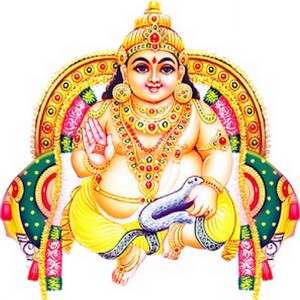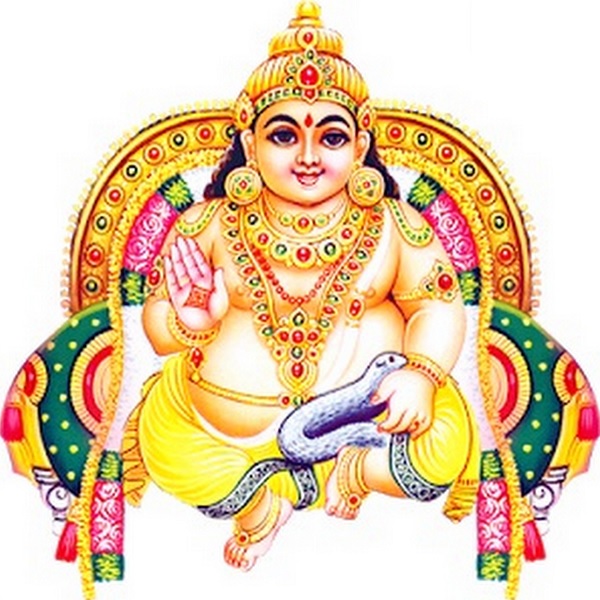No products in the cart.
Lord Kubera – Hindu Gods and Deities
 Kubera is the Lord of Wealth. Kubera is also principally revered as the God who bestows fortunes and prosperity. He is deputed as the king of Yakshas, who assist him in safeguarding the treasures lying in the lap of the earth and in the roots of the trees. He is always remembered with the goddess of fortune, Lakshmi. As the God of wealth and material, his responsibilities are to distribute them while creating wealth is the responsibility of Lakshmi.
Kubera is the Lord of Wealth. Kubera is also principally revered as the God who bestows fortunes and prosperity. He is deputed as the king of Yakshas, who assist him in safeguarding the treasures lying in the lap of the earth and in the roots of the trees. He is always remembered with the goddess of fortune, Lakshmi. As the God of wealth and material, his responsibilities are to distribute them while creating wealth is the responsibility of Lakshmi.
He is also deputed as one of the Dikpala and Lokpalas (custodians of the directions). He has been accorded exclusive authority over the North direction (Uttara disha). Kubera is not an important deity and his images are very rarely seen, though he is frequently referred to in the epics.
Kubera is one god that all the three religions of India namely Hinduism, Buddhism, Jainism all claim to be their own.
NAMES OF LORD KUBERA
The exact origins of the name Kubera are unknown. “Kubera” or “Kuvera” (कुवेर) as spelt in later Sanskrit, means “deformed or monstrous” or “ill-shaped one”; indicating his deformities. Another theory suggests that Kubera may be derived from the verb root kumba, meaning to conceal. Kuvera is also split as ku (earth), and vira (hero).
As the son of Vishrava (“Fame”), Kubera is called Vaisravana (in the Pali language, Vessavana) and as the son of Ilavila, Ailavila. Vaisravana is sometimes translated as the “Son of Fame”. The Sutta Nitapa commentary says that Vaisravana is derived from a name of Kubera’s kingdom, Visana. Once, Kubera looked at Shiva and his wife Parvati with jealousy, so he lost one of his eyes. Parvati also turned this deformed eye yellow. So, Kubera gained the name Ekaksipingala (“one who has one yellow eye”). He is also called Bhutesha (“Lord of spirits”) like Shiva. Kubera usually is drawn by spirits or men (nara), so is called Nara-vahana, one whose vahana (mount) is nara. Hopkins interprets naras as being water-spirits, although Mani translates nara as men. Kubera also rides the elephant called Sarvabhauma as a loka-pala. His garden is named Chaitrarath.
Kubera also enjoys the titles “king of the whole world”, “king of kings” (Rajaraja), “Lord of wealth” (Dhanadhipati) and “giver of wealth” (Dhanada). His titles are sometimes related to his subjects: “king of Yakshas” (Yaksharajan), “Lord of Rakshasas” (Rakshasadhipati), “Lord of Guhyakas” (Guhyakadhipa), “king of Kinnaras”(Kinnararaja), “king of animals resembling men” (Mayuraja), and “king of men” (Nararaja). Kubera is also called Guhyadhipa (“Lord of the hidden”). The Atharvaveda calls him the “god of hiding”.
Lord Kubera is the ‘treasurer of the gods’ and ‘king of Yaksha’. He is a true representation of wealth, prosperity and glory. Lord Kubera not only distributes, but also maintains and guards all the treasures of this universe. Hence, he is also known as guardian of wealth.
KUBERA AND LORD VENKATESWARA
Crores of devotees throng the world-famous Tirupati temple in South India. Kubera figures as a prominent entity in the temple as the ritual of donation is connected to Him. It is believed that Kubera lent some money to the god Venkateshwara (a form of Lord Vishnu) for his marriage with Padmavati. In commemoration of this, devotees donate money in Venkateshwara’s Hundi (donation pot) in the temple on behalf of Lord Venkateshwara as an act of repaying the loan to Kubera.
KUBERA AND RAVANA
Kubera was originally the ruler of Lanka but His scheming step-brother Ravana supplanted Him by performing severe austerities to obtain powers for that. He also seized Kubera’s magic vehicle Pushpaka and banished Him from lanka. Vishwakarma, the builder of the Gods created a new abode for him called Alaka or Alakapuri in the Himalayas. Alakapuri was in close proximity to Mount Kailash, the abode of Lord Shiva. His new kingdom was splendid and opulent beyond imagination. He also owned a beautiful garden called Chaitrarath on Mount Mandara. Since it was located in the North, the direction Kubera rules, it was ideal for Him to dwell in and discharge His duties of safeguarding treasures of gold, silver, jewels, pearls and the nine Nidhis (special treasures) on the earth.
FAMILY
Lord Kubera comes from family tress of Lord Brahma. Kubera is basically believed to be the son of Sage Vishrava who also fathered Ravana and his wife Illavida. Vishrava also married the demon princess Kaikesi, who mothered four children: Ravana, Kumbhakarna, Vibhishana and Surpanakha. So Lord Kubera is also the half-brother of Ravana. According to some mythological beliefs, Kubera was also Lord Brahma’s grandson who deserted his father Vishrava and went to live with his grandfather. Pleased with his act, Lord Brahma conferred immortality upon him and also the all the riches of the world (Nidhis). Lord Brahma also awarded him Pushpaka, a spectacular gigantic aerial vehicle that would transport him anywhere at a speed willed by him.
Kubera is married to Kauberi and they have four children. Three sons are called Nalakubara, Manigriva, Mayuraja and a daughter called Meenakshi. Devi Kauberi is also known as Yakshi, Bhadra and Charvi.
ICONOGRAPHY
In the Vishnudharmottara Purana, Kubera is described as the embodiment of both Artha (“wealth, prosperity, glory”) and Arthashastras, the treatises related to it—and his iconography mirrors it. ‘Kubera’ in Sanskrit means ill Shaped or deformed. Kubera is often depicted as a dwarf, with fair complexion (as that of lotus leaves) and a big belly. He is often shown with only one eye (believed to be lost due to an angry reaction from Goddess Parvati who once mistook him to be winking at her lustily), three legs and a set of only eight teeth.
He rides a man—the state personified, adorned in golden clothes and ornaments, symbolizing his wealth. His left eye is yellow. He wears armour and a necklace down to his large belly. The Vishnudharmottara Purana further describes his face to be inclined to the left, sporting a beard and mustache, and with two small tusks protruding from the ends of his mouth, representing his powers to punish and to bestow favours. His wife Riddhi, representing the journey of life, is seated on his left lap, with her left hand on the back of Kubera and the right holding a ratna-patra (jewel-pot). Kubera should be four-armed, holding a gada (mace: symbol of dandaniti—administration of justice) and a shakti (power) in his left pair, and standards bearing a lion—representing Artha and a shibika (a club, the weapon of Kubera). The nidhi treasures Padma and Shankha stand beside him in human form, with their heads emerging from a lotus and a conch respectively.
The Agni Purana states that Kubera should be installed in temples as seated on a goat, and with a club in his hand. Kubera’s image is prescribed to be that of gold, with multi-coloured attributes. In some sources, especially in Jain depictions, Kubera is depicted as a drunkard, signified by the “nectar vessel” in his hand.
In Tibet, the mongoose is considered a symbol of Kubera’s victory over Nāgas—the guardians of treasures. Kubera is usually depicted with a mongoose in Buddhist iconography.
FESTIVALS
- Dhanteras – Dhanteras is also known as Dhantrayodashi and it is the most important festival dedicated to Lord Kubera. Devotees perform Kubera Lakshmi Puja and buy gold on this day.
- Sharad Purnima – Sharad Purnima marks the birthday of Lord Kubera. Hence offering prayers to Kubera on this day holds immense significance.
- As Trayodashi and Purnima Tithi are historically associated with Lord Kubera, Trayodashi and Purnima Tithi(s) are considered most suitable to perform Kubera Puja to seek his blessings.
MANTRA
- Kubera Gayatri mantra:
“Om Yaksha Rajaya Vidmahe, Vaishravanaya Dimahi, Tanno Kuberah Prachodayat“
Meaning: We pay obeisance to Kubera, the king of the Yakshas and son of Vishrava.. We request the great Lord of wealth and fortune to bless us”.
“Om Yakshyaya Kuberaya Vaishravanaaya Dhanadhanyadi Padayeh Dhana-Dhanya Samreeddhing Me Dehi Dapaya Swaha“
Meaning: Kubera, the lord of yakshas, bless us with wealth and prosperity.
TEMPLES OF LORD KUBERA
- Dhopeshwar Mahadev, Madhya Pradesh – This temple expresses the bonding between Lord Shiva and Lord Kubera. It has a unique idol of Shiva and Kubera in which both deities are shown together.
- Kubera Bhandari Temple, Gujarat – Situated on the banks of river Narmada this is the place where Lord Kubera performed his penance. It is believed that Lord Shiva built this temple around 2500 years ago. He also organized a Bhandara (free food donation) at this place.


